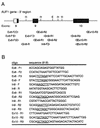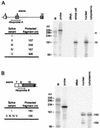Regulation of AUF1 expression via conserved alternatively spliced elements in the 3' untranslated region
- PMID: 10330146
- PMCID: PMC104365
- DOI: 10.1128/MCB.19.6.4056
Regulation of AUF1 expression via conserved alternatively spliced elements in the 3' untranslated region
Abstract
The A+U-rich RNA-binding factor AUF1 exhibits characteristics of a trans-acting factor contributing to the rapid turnover of many cellular mRNAs. Structural mapping of the AUF1 gene and its transcribed mRNA has revealed alternative splicing events within the 3' untranslated region (3'-UTR). In K562 erythroleukemia cells, we have identified four alternatively spliced AUF1 3'-UTR variants, including a population of AUF1 mRNA containing a highly conserved 107-nucleotide (nt) 3'-UTR exon (exon 9) and the adjacent downstream intron (intron 9). Functional analyses using luciferase-AUF1 3'-UTR chimeric transcripts demonstrated that the presence of either a spliceable or an unspliceable intron 9 in the 3'-UTR repressed luciferase expression in cis, indicating that intron 9 sequences may down-regulate gene expression by two distinct mechanisms. In the case of the unspliceable intron, repression of luciferase expression likely involved two AUF1-binding sequences, since luciferase expression was increased by deletion of these sites. However, inclusion of the spliceable intron in the luciferase 3'-UTR down-regulated expression independent of the AUF1-binding sequences. This is likely due to nonsense-mediated mRNA decay (NMD) owing to the generation of exon-exon junctions more than 50 nt downstream of the luciferase termination codon. AUF1 mRNA splice variants generated by selective excision of intron 9 are thus also likely to be subject to NMD since intron 9 is always positioned >137 nt downstream of the stop codon. The distribution of alternatively spliced AUF1 transcripts in K562 cells is consistent with this model of regulated AUF1 expression.
Figures










Similar articles
-
Upf1/Upf2 regulation of 3' untranslated region splice variants of AUF1 links nonsense-mediated and A+U-rich element-mediated mRNA decay.Mol Cell Biol. 2006 Dec;26(23):8743-54. doi: 10.1128/MCB.02251-05. Epub 2006 Sep 25. Mol Cell Biol. 2006. PMID: 17000771 Free PMC article.
-
Cell death inhibiting RNA (CDIR) derived from a 3'-untranslated region binds AUF1 and heat shock protein 27.J Biol Chem. 2002 Dec 6;277(49):47061-72. doi: 10.1074/jbc.M202272200. Epub 2002 Sep 27. J Biol Chem. 2002. PMID: 12356764
-
Structure and genomic organization of the human AUF1 gene: alternative pre-mRNA splicing generates four protein isoforms.Genomics. 1998 Mar 1;48(2):195-202. doi: 10.1006/geno.1997.5142. Genomics. 1998. PMID: 9521873
-
Physiological networks and disease functions of RNA-binding protein AUF1.Wiley Interdiscip Rev RNA. 2014 Jul-Aug;5(4):549-64. doi: 10.1002/wrna.1230. Epub 2014 Mar 28. Wiley Interdiscip Rev RNA. 2014. PMID: 24687816 Review.
-
Post-transcriptional control of gene expression by AUF1: mechanisms, physiological targets, and regulation.Biochim Biophys Acta. 2013 Jun-Jul;1829(6-7):680-8. doi: 10.1016/j.bbagrm.2012.12.002. Epub 2012 Dec 14. Biochim Biophys Acta. 2013. PMID: 23246978 Free PMC article. Review.
Cited by
-
RNA Degradation in Neurodegenerative Disease.Adv Neurobiol. 2018;20:103-142. doi: 10.1007/978-3-319-89689-2_5. Adv Neurobiol. 2018. PMID: 29916018 Free PMC article. Review.
-
Post-transcriptional Regulation of Gene Expression via Unproductive Splicing.Acta Naturae. 2024 Jan-Mar;16(1):4-13. doi: 10.32607/actanaturae.27337. Acta Naturae. 2024. PMID: 38698955 Free PMC article.
-
Auto- and cross-regulation of the hnRNPs D and DL.RNA. 2018 Mar;24(3):324-331. doi: 10.1261/rna.063420.117. Epub 2017 Dec 20. RNA. 2018. PMID: 29263134 Free PMC article.
-
An unappreciated role for RNA surveillance.Genome Biol. 2004;5(2):R8. doi: 10.1186/gb-2004-5-2-r8. Epub 2004 Feb 2. Genome Biol. 2004. PMID: 14759258 Free PMC article.
-
Reduction of integrin alpha 4 activity through splice modulating antisense oligonucleotides.Sci Rep. 2019 Sep 10;9(1):12994. doi: 10.1038/s41598-019-49385-6. Sci Rep. 2019. PMID: 31506448 Free PMC article.
References
-
- Atwater J A, Wisdom R, Verma I M. Regulated mRNA stability. Annu Rev Genet. 1990;24:519–541. - PubMed
Publication types
MeSH terms
Substances
Grants and funding
LinkOut - more resources
Full Text Sources
Molecular Biology Databases
Research Materials
